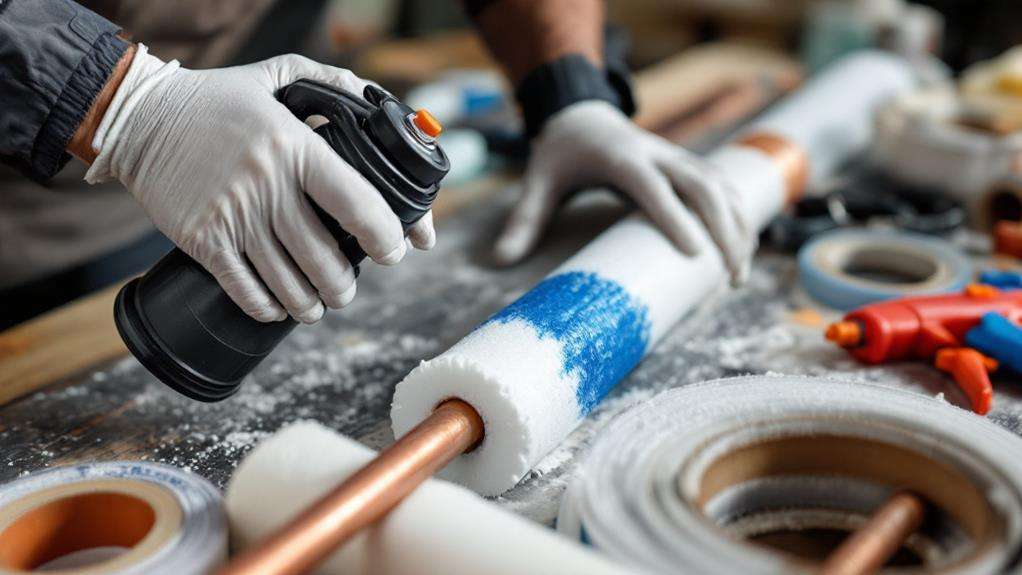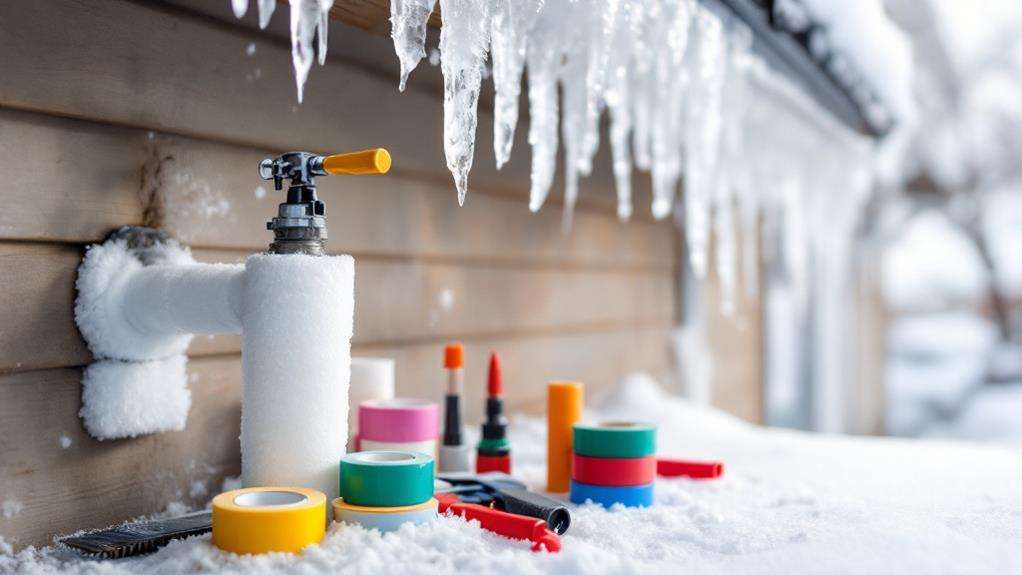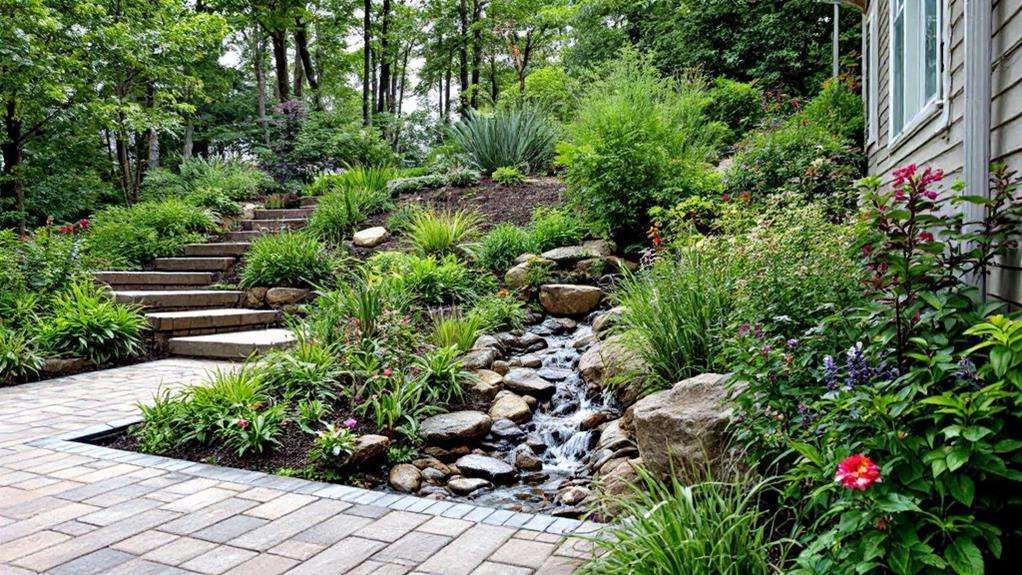Top Tools for Pipe Insulation and Winterizing Your Plumbing
To effectively insulate and winterize your plumbing, you'll need a variety of essential tools. Start with pipe insulation sleeves, a utility knife, and duct tape or zip ties. For precise measurements, use a pipe caliper and radius dividers. Don't forget adhesives and application devices like glue guns and insulator trowels. Protect yourself with N95 masks, safety glasses, and gloves. For outdoor plumbing, invest in foam faucet covers, heat tape, and insulated valve covers. In case of frozen pipes, have a hair dryer, heat gun, or electric heating cables on hand. With these tools at your disposal, you'll be well-equipped to tackle any pipe insulation or winterizing task.
Essential Pipe Insulation Tools
Preparedness is key when it comes to insulating your pipes. Before you start, gather the essential tools you'll need for the job. Head to your local hardware store and pick up pipe insulation sleeves, which come in various sizes to fit different pipe diameters. You'll also want to grab a utility knife for cutting the insulation to size and some duct tape or zip ties to secure it in place.
Don't forget to purchase faucet covers for your outdoor spigots. These inexpensive devices protect exposed faucets from freezing temperatures. While you're at it, grab a caulking gun and weatherproof caulk to seal any gaps around pipe entry points into your home.
For hard-to-reach pipes, you might need a stepladder or extension pole. A flashlight is pivotal for inspecting dark crawl spaces or attics. If you're dealing with sweating pipes, consider getting a dehumidifier to reduce moisture in problem areas.
Lastly, invest in a pipe heating cable for extremely cold climates. This self-regulating cable wraps around pipes to prevent freezing. With these tools on hand, you'll be well-equipped to insulate pipes and winterize your plumbing effectively.
Measuring and Cutting Equipment
Now that you've gathered your basic tools, let's focus on the specialized equipment for measuring and cutting pipe insulation. To guarantee your plumbing is properly protected from freezing temperatures, you'll need accurate measuring tools and sharp cutting implements.
For precise pipe measurements, the TIK-C585 Pipe Caliper is an essential tool. It'll help you determine the exact diameter of your pipes, ensuring you select the right insulation size. To complement this, use Malco Model #24 Radius Dividers and Flat Leg Wing Dividers to measure curved surfaces and determine the correct shape for your insulation.
When it comes to cutting, you'll want sharp, reliable knives. The Dexter Russell boning knives, including the 1376HB Ham Boning Knife and 1376 Rigid Boning Knife, are excellent choices for precise insulation cutting. Keep these knives sharp with a Carborundum Sharpening Stone to maintain their effectiveness throughout your project.
For trimming and shaping insulation around pipes and fittings, Channellock 7 End Nippers are priceless. They'll help you achieve a snug fit, guaranteeing no gaps in your insulation that could lead to water freezing in your pipes.
With these specialized tools, you'll be well-equipped to measure and cut pipe insulation accurately, effectively winterizing your plumbing system.
Adhesives and Application Devices

Once you've measured and cut your pipe insulation, you'll need the right adhesives and application tools to secure it properly. In cold temperatures, it's essential to have efficient tools that can help you apply adhesives quickly and accurately around pipes.
Rubber or PVC glue guns with brush tips are excellent choices for applying adhesives efficiently. These tools allow you to spread the adhesive evenly and quickly, guaranteeing a strong bond between the insulation and the pipe. After applying the adhesive, you'll want to use an insulator trowel to smooth and distribute it evenly.
For securing insulation to pipes, the G-26 outward clinch tacker is a specialized tool that uses staples. This device is particularly useful when working in tight spaces or around complex pipe configurations.
To ensure your insulation stays in place and functions effectively in cold temperatures, consider using these tools:
- Rubber/PVC glue guns with brush tips
- Insulator trowels
- G-26 outward clinch tacker
- Carborundum sharpening stones
Don't forget to maintain your cutting tools with Carborundum sharpening stones. Keeping your knives and tools sharp will make the insulation process smoother and more efficient, helping you winterize your plumbing effectively and protect your pipes from freezing temperatures.
Protective Gear for Insulation Work
While having the right tools is important, protecting yourself during insulation work is equally indispensable. When winterizing your plumbing to prevent damage from cold weather, you'll need proper safety gear to shield yourself from potential hazards.
For respiratory protection, use N95 dust masks like the 3M 8511 with exhalation valves or the 3M 8210 particulate respirators. These masks filter out fine particulates, ensuring your safety while working with insulation materials. To protect your eyes from debris and particles, wear Pyramex V3G safety glasses or goggles. They'll shield your vision as you work on unprotected plumbing in tight spaces.
Don't forget to protect your hands with rubber or PVC gloves. These will guard against adhesives and sharp edges you might encounter during pipe insulation tasks. Remember, proper hand protection is fundamental when handling various materials and tools, including space heaters you might use to keep warm while working.
Winterizing Products for Outdoor Plumbing

Outdoor plumbing frequently requires special attention when winterizing your home. To prevent freezing and protect your pipes from freezing, you'll need specific products designed for outdoor use. Start by focusing on your outdoor faucets, as they're particularly vulnerable to cold temperatures.
Invest in foam faucet covers that slip easily over your outdoor spigots. These insulated covers create a barrier against freezing air and can extensively reduce the risk of pipe damage. For exposed pipes, use foam pipe insulation sleeves that wrap around the pipes, providing an extra layer of protection.
Consider these additional winterizing products for your outdoor plumbing:
- Heat tape or heat cables to wrap around pipes in extremely cold areas
- Insulated valve covers for in-ground sprinkler systems
- Drain valves to remove water from pipes before freezing occurs
- Pipe heating systems for areas prone to prolonged freezing temperatures
Don't forget to disconnect and drain garden hoses before the first frost. Store them indoors to prevent damage and extend their lifespan. By using these winterizing products and taking preventive measures, you'll safeguard your outdoor plumbing against the harsh effects of winter weather, potentially saving you from costly repairs and inconvenient water disruptions.
Thawing Tools for Frozen Pipes
Despite your best efforts, pipes can still freeze during severe cold snaps. When faced with frozen pipes, you'll need the right tools to thaw them safely and quickly. A hair dryer is a versatile and readily available option for smaller areas. Simply direct the warm air onto the frozen section, moving it back and forth to distribute heat evenly.
For larger or harder-to-reach areas, consider using a heat gun. This powerful tool provides intense, focused heat but requires careful handling to avoid damaging pipes or surrounding materials. Electric pipe heating cables are another effective solution. Wrap these around frozen pipes to gradually thaw them.
If you can't access the frozen section directly, try using an infrared lamp. This heat source can penetrate walls and floors to warm pipes from a distance. For outdoor pipes, a propane torch can be useful, but exercise extreme caution and follow proper safety protocols.

